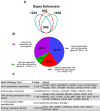Assessment of the histone mark-based epigenomic landscape in human myometrium at term pregnancy
- PMID: 40493036
- PMCID: PMC12151536
- DOI: 10.7554/eLife.95897
Assessment of the histone mark-based epigenomic landscape in human myometrium at term pregnancy
Abstract
The myometrium plays a critical role during pregnancy as it is responsible for both the structural integrity of the uterus and force generation at term. Emerging studies in mice indicate a dynamic change of the myometrial epigenome and transcriptome during pregnancy to ready the contractile machinery for parturition. However, the regulatory systems underlying myometrial gene expression patterns throughout gestation remain largely unknown. Here, we investigated human term pregnant nonlabor myometrial biopsies for transcriptome, enhancer histone mark cistrome, and chromatin conformation pattern mapping. More than thirty thousand putative enhancers with H3K27ac and H3K4me1 double positive marks were identified in the myometrium. Enriched transcription factor binding motifs include known myometrial regulators AP-1, STAT, NFkB, and PGR among others. Putative myometrial super enhancers are mostly colocalized with progesterone receptor-occupying sites and preferentially associated with highly expressing genes, suggesting a conserved role of PGR in regulating the myometrial transcriptome between species. In human myometrial specimens, inferred PGR activities are positively correlated with phospholipase C like 2 (PLCL2) mRNA levels, supporting that PGR may act through this genomic region to promote PLCL2 expression. PGR overexpression facilitated PLCL2 gene expression in myometrial cells. Using CRISPR activation, we assessed the functionality of a PGR putative enhancer 35 kilobases upstream of the contractile-restrictive gene PLCL2. In summary, the results of this study serve as a resource to study gene regulatory mechanisms in the human myometrium at the term pregnancy stage for further advancing women's health research.
Keywords: Progesterone; cell biology; chromatin; genetics; genomics; human; myometrium.
Conflict of interest statement
SW, EQ, TW, SM, XX, LL, MA, FD No competing interests declared
Figures






Update of
-
Assessment of the Histone Mark-based Epigenomic Landscape in Human Myometrium at Term Pregnancy.bioRxiv [Preprint]. 2025 Feb 26:2024.02.19.581035. doi: 10.1101/2024.02.19.581035. bioRxiv. 2025. Update in: Elife. 2025 Jun 10;13:RP95897. doi: 10.7554/eLife.95897. PMID: 40060655 Free PMC article. Updated. Preprint.
References
-
- Chawanpaiboon S, Vogel JP, Moller A-B, Lumbiganon P, Petzold M, Hogan D, Landoulsi S, Jampathong N, Kongwattanakul K, Laopaiboon M, Lewis C, Rattanakanokchai S, Teng DN, Thinkhamrop J, Watananirun K, Zhang J, Zhou W, Gülmezoglu AM. Global, regional, and national estimates of levels of preterm birth in 2014: a systematic review and modelling analysis. The Lancet. Global Health. 2019;7:e37–e46. doi: 10.1016/S2214-109X(18)30451-0. - DOI - PMC - PubMed
MeSH terms
Substances
Associated data
- Actions
- Actions
Grants and funding
LinkOut - more resources
Full Text Sources
Research Materials

